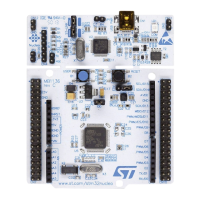ADC errors AN2834
16/49 DocID15067 Rev 3
2.1.5 Total unadjusted error
The total unadjusted error (TUE) is the maximum deviation between the actual and the ideal
transfer curves. This parameter specifies the total errors that may occur, thus causing the
maximum deviation between the ideal digital output and the actual digital output. TUE is the
maximum deviation recorded between the ideal expected value and the actual value
obtained from the ADC for any input voltage.
The TUE is denoted by E
T
. It is represented in Figure 13.
The TUE is not the sum of E
O
, E
G
, E
L
, E
D
. The offset error affects the digital result at lower
voltages whereas the gain error affects the digital output for higher voltages.
Example
If V
REF+
= 3.3 V and V
AIN
= 2 V, the ideal result is 0x9B2. However, if the conversion result
of 0x9B4 is obtained, the deviation may result from the offset since the DLE and ILE errors
occur simultaneously.
TUE = absolute (actual value – ideal case value) = 0x9B4 – 0x9B2 = 0x2 = 2 LSB
Figure 13. Total unadjusted error
1. The total unadjusted error, E
T
, is shown in magenta.

